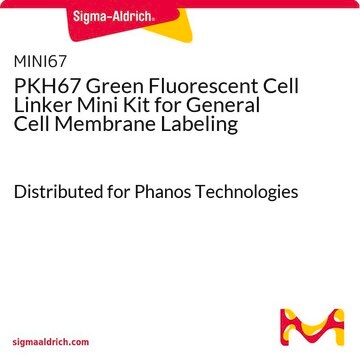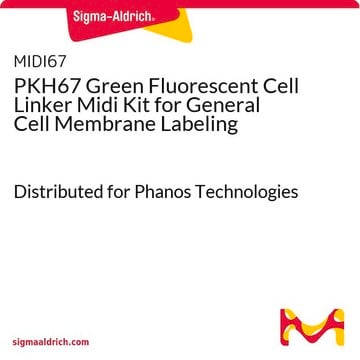Yes, Product PKH67 would be suitable for this application. In this paper, both Products PKH26 and PKH67 are used in a similar application:
https://www.ncbi.nlm.nih.gov/pmc/articles/PMC5679712/
推薦產品
品質等級
包裝
pkg of 1 kit
儲存條件
protect from light
螢光
λex 490 nm; λem 502 nm (PKH67 dye)
檢測方法
fluorometric
運輸包裝
ambient
儲存溫度
room temp
相關類別
應用
在采用PKH1和PKH2进行的体内研究中,荧光强度都会缓慢损失。由于这是绿色细胞linker染料而非红色细胞linker染料出现的行为特征,因而PKH67会出现类似的性质。不分裂细胞的体外细胞膜留存和体内荧光半衰期的关联性揭示,PKH67的体内荧光半衰期为10-12天。其他具有类似半衰期的绿色细胞linker染料已经被用于监测1-2月内的体内 淋巴细胞和巨噬细胞运输,结果表明PKH67还可用于中等时长的体内跟踪研究。
聯結
法律資訊
僅套裝組件
- Diluent C 6 x 10
- PKH67 Cell Linker in ethanol .5 mL
訊號詞
Danger
危險聲明
危險分類
Eye Irrit. 2 - Flam. Liq. 2
儲存類別代碼
3 - Flammable liquids
閃點(°F)
57.2 °F - closed cup
閃點(°C)
14 °C - closed cup
客戶也查看了
文章
PKH dyes are easy to use and achieve stable, uniform, and reproducible fluorescent labeling of live cells. PKH dyes are non-toxic membrane stains which produce high signal to noise ratio.
PKH 染料使用方便,可實現活細胞的穩定、均勻和可重複的螢光標記。PKH 染料是無毒的膜染色劑,可產生高信噪比。
Lipophilic cell tracking dyes enable cancer biologists to track tumor and immune cell functions both in vitro and in vivo. Read the article to choose a right membrane dye kit for cell tracking and proliferation monitoring.
親油性細胞追蹤染料可讓癌症生物學家在體外和體內追蹤腫瘤和免疫細胞的功能。閱讀文章,選擇合適的膜染料試劑盒進行細胞追蹤和增殖監測。
-
I mark mitochondria for injection with PKH26 Red Fluorescent Cell Linker Kit for General Cell Membrane Labeling. I want to use another dye to mark another type of mitochondria and inject them together in the same fish egg. Is PKH67 ok for this like PKH26?
1 answer-
Helpful?
-
-
What can be the alternative for removing excess dye after labeling of exosomes using PKH67 dye apart from ultracentrifugation?
1 answer-
Excess dye is bound to serum or albumin which is added to the cell/dye mixture as a stop reaction. The recommended clean up or dye removal is by standard centrifugation (400 x g for 10 minutes, wash, and repeat). See the Product Information Sheet, page 3, bullet point 8 for more information:
https://www.sigmaaldrich.com/deepweb/assets/sigmaaldrich/product/documents/984/984/pkh67glbul.pdfAlternate methods for excess dye removal have not been investigated.
Helpful?
-
-
Can we remove the excess PKH67 DYE used for the labeling of exosomes using exosome spin column rather than ultracentrifugation.
1 answer-
The recommended exosome labeling protocol has been optimized to assure the best possible results. The use of exosome spin columns with the PKH and CellVue products has not been validated. See below for a link to our exosome labeling protocol. A spin column method may not offer the best results.
Helpful?
-
-
Will Product PKH67, Green Fluorescent Cell Linker Kit, stain dead cells?
1 answer-
As long as the cell has an intact membrane, the PKH76 dye can label the cell.
Helpful?
-
-
What is the difference between Green Fluorescent Cell Linker Kits PKH2 and PKH67?
1 answer-
PKH2 was one of the early PKH dyes. The PKH67 dye has a longer aliphatic tail. There is reduced cell-celldye transfer for PKH67 as compared with PKH2.
Helpful?
-
-
What method of fixation can be used for tissue/cells with the PKH Fluorescent Cell Linker Kit for General Cell Membrane Labeling dyes?
1 answer-
A protocol for visualization of tissue sections can be found in the technical bulletin. For visualization of stained cells by immunofluorescence or flow cytometry, the cells can be fixed in 2% paraformaldehyde for 15 minutes. The use of other organic solvents will extract the dye from the cells. If internal labeling is desired, the cells can be permeabilized with saponin (50-75 μg/mL). Here is the link to the Troubleshooting Guide.
Helpful?
-
-
What is the Department of Transportation shipping information for this product?
1 answer-
Transportation information can be found in Section 14 of the product's (M)SDS.To access the shipping information for this material, use the link on the product detail page for the product.
Helpful?
-
-
What is the excitation and emission spectra for Product PKH67GL, Green Fluorescent Cell Linker Kit?
1 answer-
The spectra can be found on the product insert.The product has a maximum excitation at 490 nm and maximum emission at 502 nm.
Helpful?
-
-
How many cells can be stained with Product PKH67GL, Green Fluorescent Cell Linker Kit?
1 answer-
This kit can stain 50 × 107 cells if used as directed (1 × 107 cells stained with 2 × 10-6 M PKH67).
Helpful?
-
-
When using Product PKH67GL, PKH67 Green Fluorescent Cell Linker Kit for General Cell Membrane Labeling, how long will the cells remain stained after treatment?
1 answer-
Labeled cells that have been washed can be visualized in culture up to 100 days after staining (for non-dividing cells). The dye itself is stable and will divide equally when the cells divide. After staining with PKH dyes, you can observe as many as 8 divisions depending on how brightly the cells were stained initially and the amount of surface area on the cells. Most commonly, 4-6 divisions can be visualized.
Helpful?
-
Active Filters
我們的科學家團隊在所有研究領域都有豐富的經驗,包括生命科學、材料科學、化學合成、色譜、分析等.
聯絡技術服務














